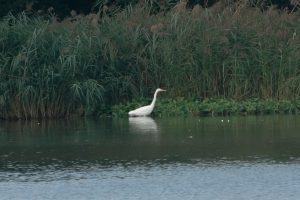William Legge writes:
Following a glorious June, hopes of another fine summer were short lived as the Jetstream moved south resulting in a very unsettled July. As a procession of strong weather systems swept in off the Atlantic it was colder and wetter than we have seen in years. August wasn’t much better, but thankfully summer resumed in September when high pressure took hold and at times it was outright hot.
While large mats of algae developed over much of the Pond during the summer months, it appears that the lower temperatures, ample summer rainfall and better water quality prevented any serious blue-green algae blooms. Encouragingly there was a repeat of last year’s abundant growth of Lesser Pondweed, Potamogeton pusillus, which again attracted record numbers of wildfowl as the autumn progressed.
Autumn Migration
Picking up from my last report, early southbound waders continued to be seen with a Common Sandpiper on July 3rd (concerningly the only one reported this autumn), an overflying Curlew heard during a scheduled moth session at 00:12 hours on July 8th and the fifth Common Redshank of the autumn on the evening of July 16th.
Other early autumn migrants included several large gatherings of Common Swifts and Sand Martins feeding over the Pond, brought in by heavy rain showers, including 200 Swifts on 3rd and 13th July and 200 Sand Martins on 14th. Up to three Common Terns were regular visitors in late July into the first week of August and a lone Ring-necked Parakeet was sighted on July 3rd at the station car park trees, leaving southwest low over Chestnut Grove.
Egrets were well represented, with up to six Little Egrets roosting throughout the period. A single Great White Egret was logged on July 3rd (a flyover heading NE) and with others present on September 1st and 25th (single pictured above). However, ‘egret top honours’ go to a Cattle Egret that was sighted preening on Cormorant Island on August 16th. It was subsequently sighted roosting in the evenings with Little Egrets up until at least August 19th, representing the second record for the reserve (illustrated below).
Passerine migrants were few, with the most notable coming from the MoD Fields adjoining the eastern boundary of the reserve, with a Tree Pipit on August 14th, a Spotted Flycatcher on August 20th and four Willow Warblers also on the 20th. High counts of local breeders, perhaps swelled by newly arrived migrants, included 27 Whitethroat on August 14th and up to 13 Stonechat in early September. One or two Raven were a regular feature around the MoD Fields between mid-August and early September. After an apparent absence of a few months, a Cetti’s Warbler was heard singing on September 9th and up to three located by the end of the month scattered in the reedbeds between Wellington Avenue and Lions’ View.
Wildfowl success
It was an excellent few months for wildfowl, attracted by abundant growth of Lesser Pondweed and several record counts were logged. Gadwall numbers were the first to peak with 88 counted on July 28th rising to 116 on August 9th (including 12 locally raised young). Numbers remained elevated into early October with 103 counted on October 10th. Shoveler numbers were slower to increase with low single digit counts in July rising to 20 by August 20th, 55 by September 26th and a new reserve record count of 86 on October 9th. Other notable wildfowl high counts included 20 Teal on September 17th, 55 Tufted Duck on October 10th, five Pochard on September 23rd and three Mandarin Duck between August 24th-26th.
The second Garganey of the autumn, a male was sighted on August 5th and what is presumed the same individual was sighted again August 18th and September 2nd. The first Eurasian Wigeon (illustrated above) of the autumn was logged on September 11th and was followed by a series of sightings in early October including a flock of eight on October 10th.
The Pink-footed Goose (last goose in group pictured above) returned on July 31st for its third autumn in a row, roosting nightly, accompanying Greylag Geese and was seen up until at least August 26th. However, geese numbers were down on 2022 levels with early morning roost counts peaking at 254 Greylag Geese and 184 Canada Geese on August 26th. Coot numbers were again elevated, gorging on Lesser Pondweed with another reserve record broken when 263 were logged on September 2nd.
A juvenile Little Grebe (illustrated above) was sighted on July 13th and reports were regular thereafter with two sighted on August 6th, and three on August 17th. Great Crested Grebes numbers were subdued with the highest count reported being ten on October 10th.
Further interesting sightings
Other notable autumn sightings included an immature female Marsh Harrier briefly tussling with a local Red Kite over the Pond, before leaving northeast on August 19th. A Peregrine Falcon briefly on October 2nd and several sightings of Hobby including two juveniles feeding on dragonflies on September 29th. Visible migration counts were limited this autumn but did include movements of 571 House Martin over southwest between September 23rd-26th and the first Redwing of the autumn heading over southwest on September 26th. Notable early autumn roosts included 23 Cormorants on September 24th and 365 Jackdaws on September 25th.
As the days grow shorter and the weather colder, expect higher roost numbers as we head into the winter months. Good birding!
Contributing Observers: TS AuYeung, David Buckler, John Clark, William Legge, Spike Millington, Sue Potter, A Robjohns, Graham Stephenson, Geth Tillin and CH Wan.
Photograph credits: Great Egret, Pink Footed Goose—William Legge
Bird illustrations —RSPB www.rspb.org.uk/birds-and-wildlife/wildlife-guides/bird-a-z/





